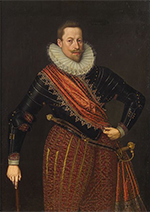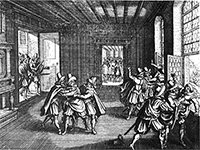Matthias: King of Germany, Holy Roman Emperor
Matthias was King of Germany and Holy Roman Emperor for a time in the early 17th Century. He was on the imperial throne when the Thirty Years War began. 
He was born on Feb. 24, 1557, in Vienna. His father was the eventual Holy Roman Emperor Maximilian II. Matthias had two older brothers and so was not expected to inherit much from his father. The honor of heir apparent belonged to Matthias's oldest brother, Rudolf, who gained the crowns of Bohemia, Germany, and Hungary in short order, beginning in 1575. Three years later, Matthias, who despite have no crowns was known to various parties throughout Europe, accepted the position of Governor-General of the States-General of the Spanish Netherlands. At the time, a significant part of the Netherlands had risen up against the rule of King Philip II of Spain. Matthias was in that primary position when the United Provinces declared full independence from Spain, in 1581. Philip II removed Matthias from his position after the latter failed to to bring about either peace or reconciliation. Returning to Austria, Matthias set about seeking other political appointments. He finally got one in 1593, assuming a high-ranking position in the Austrian government. Long a proponent of the Protestant movement, Matthias changed course in the mid-1590s, acting to suppress opposition to Catholic policies. Also during this time, Matthias called out the army (two different times) to quell uprising by farmers in two parts of Austria. His brother, Rudolf, meanwhile, had assumed the imperial throne as well, their father having died in 1576. Rudolf moved the imperial court to Prague in 1583 and spent large amounts of time and money building up his own personal collection of art, scientific instruments, and exotic plants and animals. He also, in 1593, entered into a war with the Ottoman Turks that lasted more than a decade. It was Matthias, eventually, who, after serving as commander-in-chief of the imperial troops, hammered out a peace agreement with the Ottomans. Rudolf had lost credibility with many of his subjects, including powerful nobles, by this time, and he had to hand over the thrones of Austria and Hungary to Matthias. He included the Bohemian crown two years later, after trying to play both sides of the Catholic-Protestant division and succeeding only in alienating both Bohemian Catholics and Bohemian Protestants. Further, in 1611, Matthias led an army into Rudolf's castle in Prague and held the emperor prisoner. By this time, Matthias was clearly the power behind the throne. Rudolf, thus imprisoned and stripped of his effectiveness, died, on Jan. 20, 1612. It was on that day that Matthias technically became Holy Roman Emperor, although he was officially recognized as such two weeks later. Matthias inherited a seething cauldron of dissent within Europe. The revolt and independence of the United Provinces of the Netherlands had both political and religious intent. As well, the Catholic Church, after years of at least appearing to accede to Protestant demands, had launched the Counter-Reformation, a reaffirmation of basic Church principles; the result was even more struggles, many of them violent, throughout the German states and throughout the empire. In 1618, the Austrian archduke, Ferdinand II, was also the King of Bohemia. A devout Catholic, he sought to impose Catholicism on his subjects, who lived in what is now Austria and the Czech Republic. Ferdinand sent a handful of royal representatives to meet with a number of Bohemian nobles at This powerful act of aggression was the powderkeg that set off the Thirty Years War. Matthias was still Holy Roman Emperor when the war began, but he played little part in the prosecution of it. In fact, he had already give up the day-to-day running of the empire, ceding that responsibility to his chief adviser, the cleric Melchior Klesl. Matthias had married his cousin Archduchess Anna of Austria, on Dec. 4, 1611; the couple had no children. Thus, Matthias had no son to succeed him when he died, on March 20, 1619, in Vienna. His successor, therefore, was his cousin Ferdinand II, whom he had adopted as his son a few years earlier. |
|
Social Studies for Kids
copyright 2002–2026
David White



 Prague Castle. The locals were so offended with Ferdinand's heavy-handed "proposal" that they threw his representatives out a window. Such began the open revolt that unofficially began the
Prague Castle. The locals were so offended with Ferdinand's heavy-handed "proposal" that they threw his representatives out a window. Such began the open revolt that unofficially began the 
